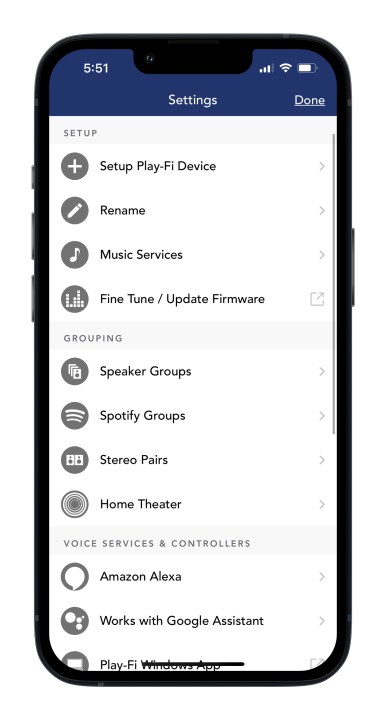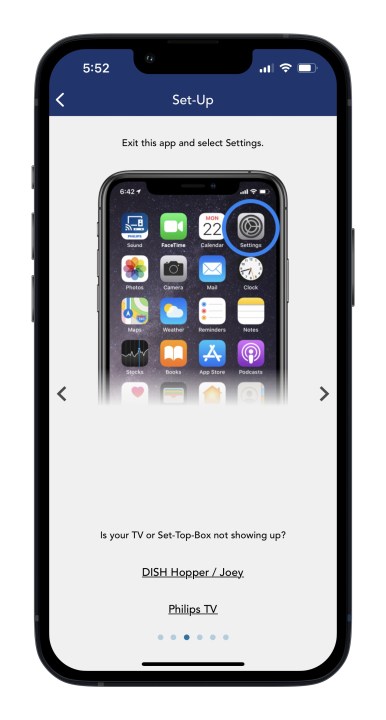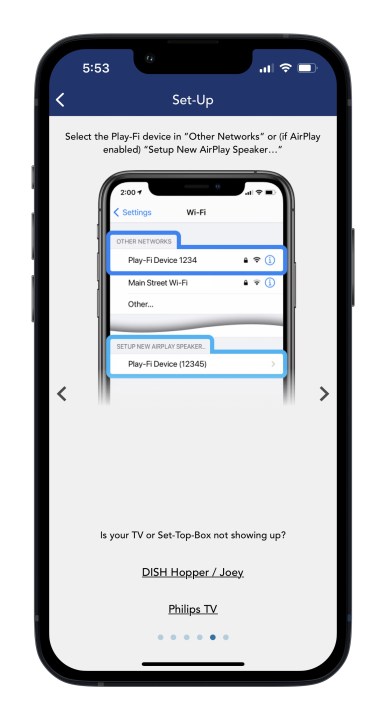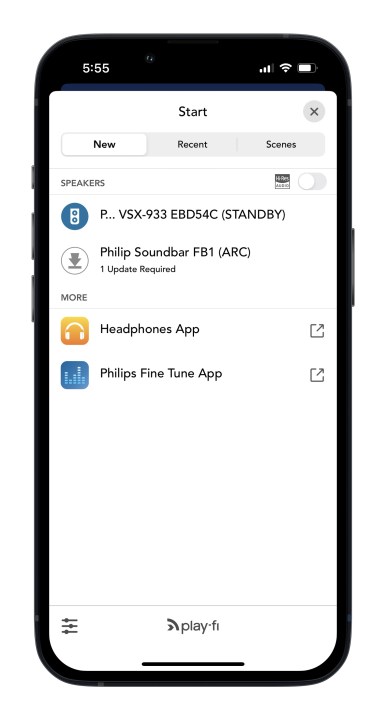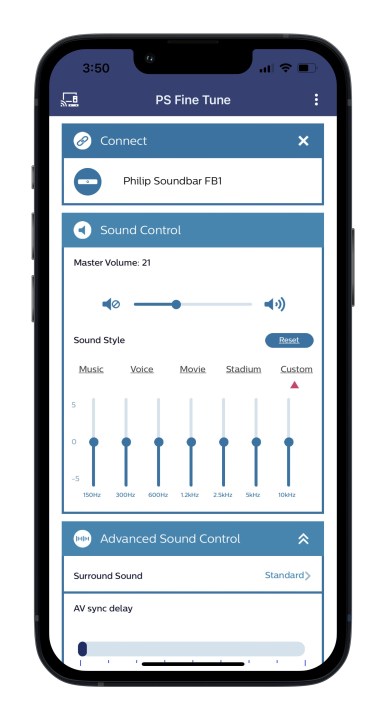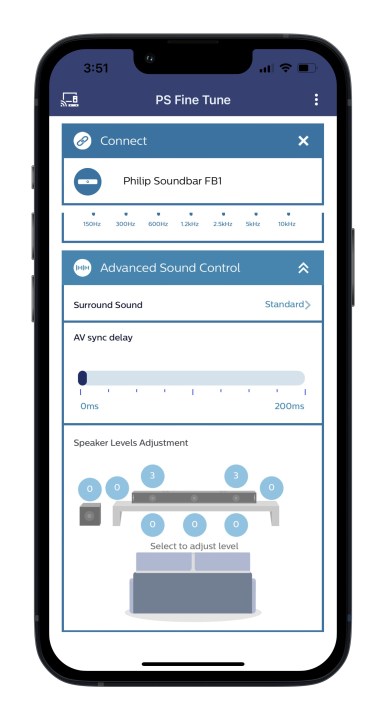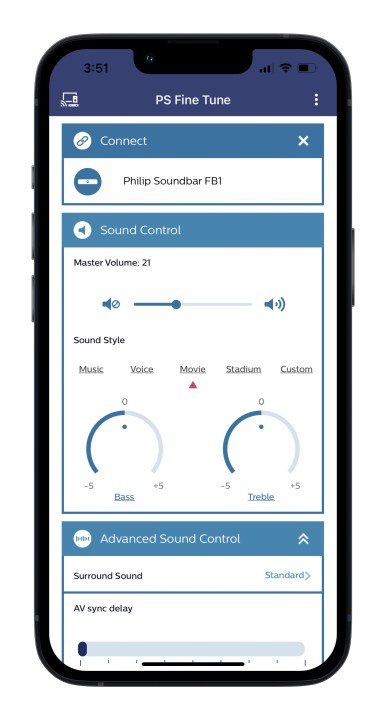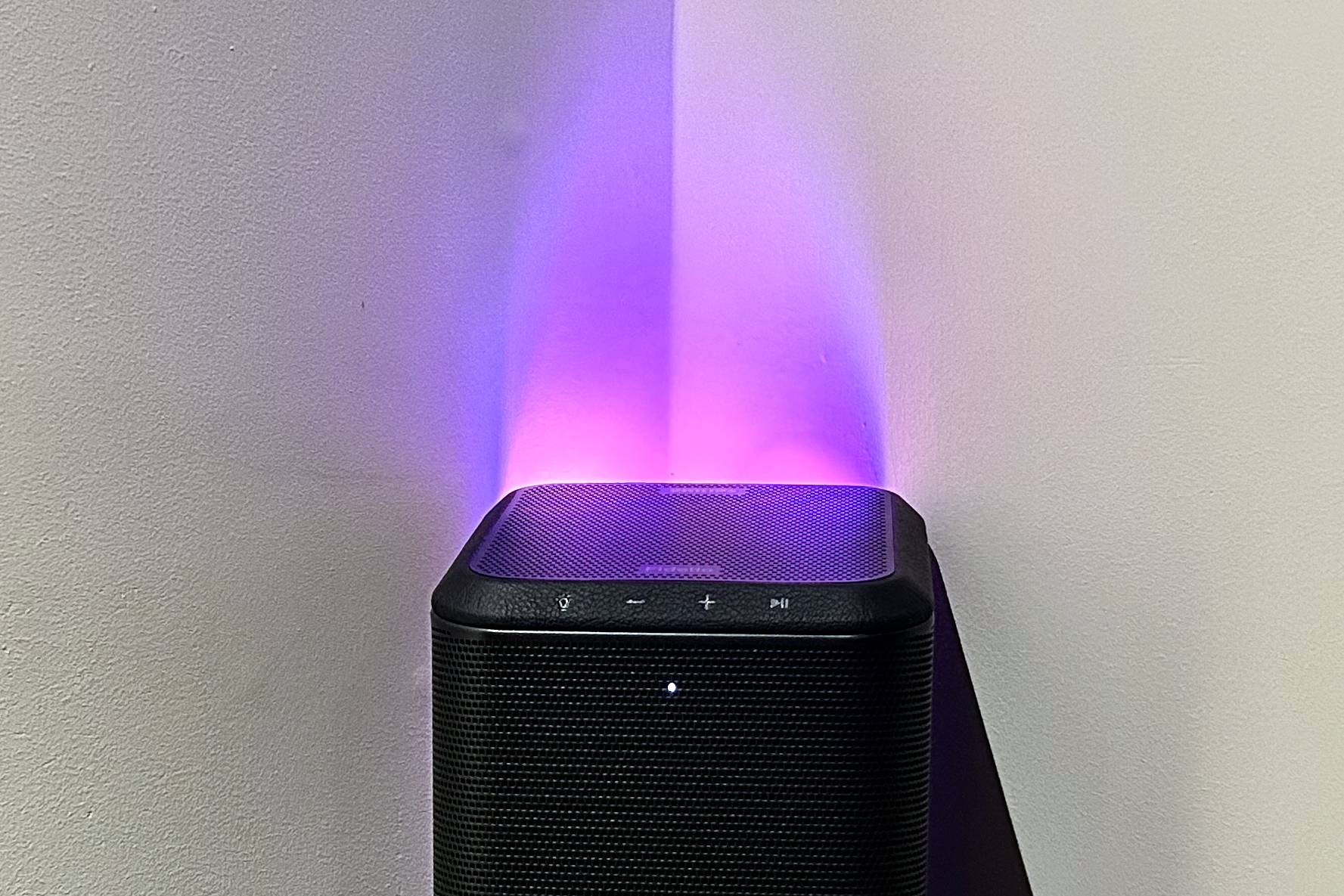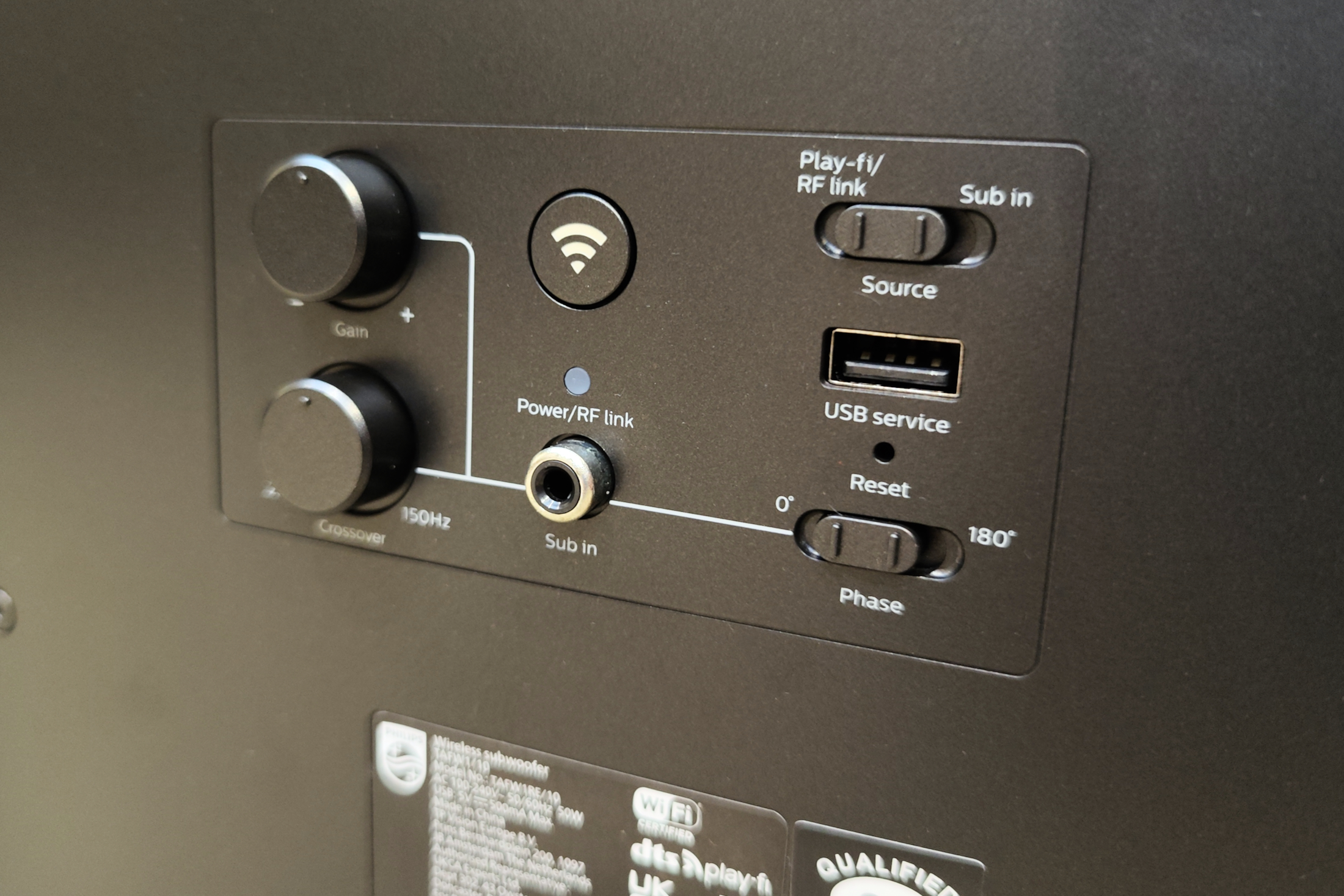“Outstanding bass and power make the Philips Fidelio FB1 a fantastic single-speaker soundbar.”
- Very powerful Dolby Atmos sound
- Excellent bass response
- Room calibration
- Tons of audio settings
- Airplay/Chromecast/hi-res audio
- Confusing, two-app setup
- Sync issues when adding surrounds and sub
- No instruction manual in the box
Adding a soundbar to your TV is the easiest and most affordable way to get much better audio for your favorite shows and movies. And if you’re wondering which Dolby Atmos soundbar gives you the absolute biggest bang for the buck, the answer is the Philips Fidelio FB1.
At $799, it’s less expensive than competing models like the $899 Sonos Arc, $899 Bose Smart Soundbar 900, and $1,000 Sony HT-A5000, and yet the FB1 is an absolute beast. It produces 630 peak watts of immersive power through a 15-driver, 7.1.2-channel system that those other models can’t match, making it the sledgehammer of soundbars.
The catch? Sledgehammers aren’t always the right tool for the job. Read on to find out why.
LEDs and leather
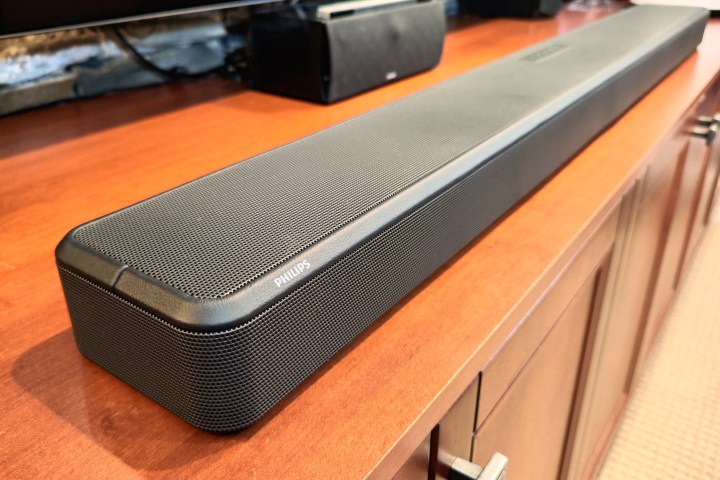
At about 47 inches long, it’s just a tad narrower than the bottom of a 65-inch TV. It stands only 2.8 inches tall, which shouldn’t block your screen or your TV’s remote signals. But if it does, the FB1 comes with an optional wired infrared transmitter that you can mount to your TV’s IR receiver.
In the box, you’ll find a wired microphone for room calibration, a remote with batteries, a power cord, and a set of wall-mount brackets. Curiously, Philips doesn’t include an HDMI or optical cable. So if you don’t already own one, make sure you add it to your shopping cart. A far worse omission, however, is the lack of a full user manual. Trust me when I say download the manual now — you’re going to need it.
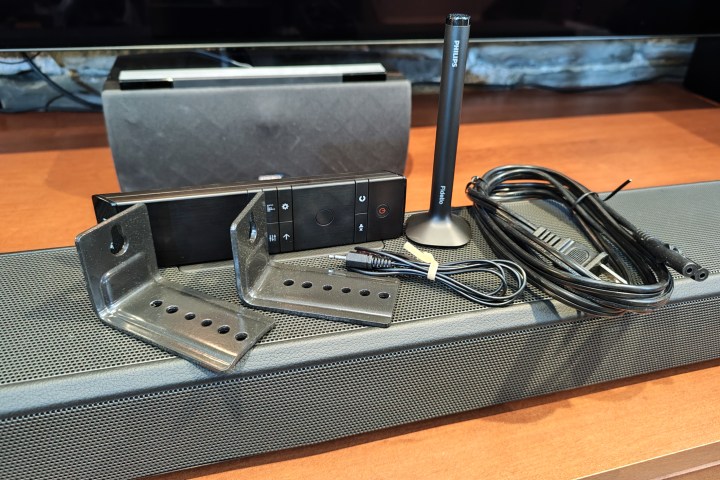
In terms of design, there’s hardly a hint of the power lurking inside the Fidelio FB1. Dressed entirely in black, with a metal grille that covers the top and wraps around the front and sides, it’s an understated affair. Philips even adds a touch of sophistication with real leather trim around the top edges. It’s not at all clear to me why leather was chosen, especially as there’s so little of it, but it’s a detail the company uses on its other Fidelio components.
There’s a very bright alphanumeric display behind the front grille (which thankfully can be dimmed), but the real surprise is that Philips has chosen to add LED lighting to the FB1’s up-firing height drivers. I say it’s a surprise because they light up whenever a Dolby Atmos signal is detected. It’s a totally gratuitous feature — the front display will tell you if you’re listening to Atmos, making the rings unnecessary. Mercifully, the default setting turns them off after 10 seconds and you can disable them entirely. Or, keep them on the whole time! I guess I shouldn’t be surprised that the company, which has been championing its TV-based Ambilight feature for years, likes to put LEDs on its other products too.

Around the back, you’ll find an HDMI input, a two-way HDMI ARC/eARC port, an optical connection, and a USB port. There are no analog inputs and there’s no Ethernet jack, so it’s Wi-Fi only for all network features. There’s also the IR blaster output and the calibration mic input. Having an HDMI input, especially one that supports 4K and Dolby Vision passthrough, is helpful for those who are running low on HDMI inputs on their TVs, but gamers beware: you only get 4K at 60Hz, and there’s no variable refresh rate, so you’ll probably want to keep your Xbox or Playstation connected directly to your TV.
More apps, more confusion
Getting the FB1 set up should be a relatively straightforward process, but interpreting the included quick-start guide will require Ikea levels of patience. Right off the bat, it recommends that you download the Philips Sound app to your phone. But then it ignores the app until the fifth setup step. Even more baffling is the total absence of any mention of the calibration mic, or how to use it. Like I said earlier, you’re going to need the full manual.
When you do get to the app-based step, which is how you get the FB1 connected to your Wi-Fi, you’ll be asked to jump back and forth between the Philips Sound app and your phone’s Wi-Fi settings to get things working. There was a step that involved setting up the speaker using AirPlay, which I was able to do on my iPhone, but the quick-start guide made no mention of how Android users were supposed to get this part working (AirPlay is not supported on Android).
When you’re finally done, be prepared for some additional confusion. It turns out the Philips Sound app can be used to set up the FB1, update its firmware, and play music to it from the list of supported streaming music services, but it can’t access any of the soundbar’s settings except volume. If you want an app for that, you’ll need to download a secondary app called Philips Fine Tune (or PS Fine Tune, as it’s actually listed in the App Store).
I wish I could tell you, don’t bother, you don’t really need the PS Fine Tune app. Except that you do, unless you don’t mind trying to navigate the FB1’s multi-layered settings menus via the five-character display on the front of the speaker using the included remote. I’ve tried; it was not fun.
Why, you’re no doubt asking, has Philips created such a terrible user experience? It’s an unfortunate byproduct of the technology the company is using for its multiroom and multispeaker control: Play-Fi by DTS. Unlike Bose, Sonos, or Sony, each of which has developed its own proprietary systems, Philips chose to work with DTS.
The advantages to Philips are obvious. All it had to do was build a speaker that’s compatible with Play-Fi and then take the generic Play-Fi app and put a Philips skin on it. Are there advantages to those of us who end up using the product? Perhaps. In theory, you can mix and match any Play-Fi compatible products within your home, avoiding the lock-in that the proprietary systems require. But having now seen the potential pitfalls of Play-Fi, I’m going to say that the potential upside just isn’t worth it.
I’ll discuss another problematic aspect of Philips’ Play-Fi partnership in a moment, but let’s finally talk about how the FB1 sounds.
It’s a monster of sound
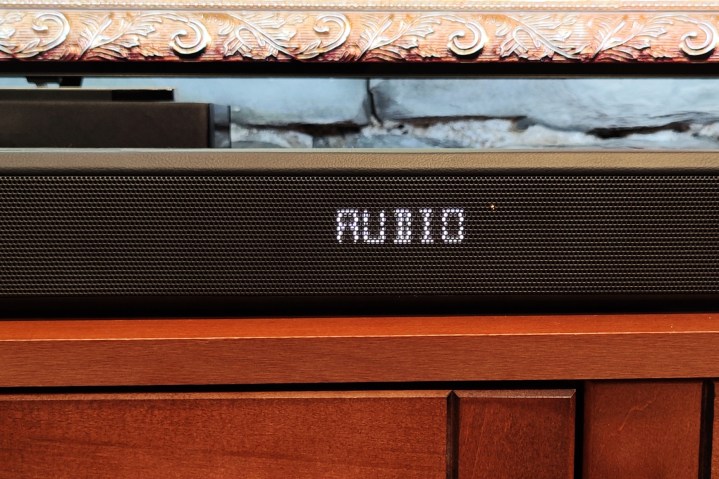
In short, the Fidelio FB1 sounds gigantic. I’ve yet to hear a soundbar at this size and price that can fill a room so effortlessly. To put it in perspective, at a volume level of 17 (about 28% of the speaker’s total power), there’s more than enough sound to enjoy casual viewing. At level 19, it’s highly engaging, and by the time you hit 21 to 23, there’s a real risk of annoying anyone who shares an adjoining condo or semi-detached house.
What’s really striking — beyond the sheer volume level — is the bass. Because of their size and shape, soundbars generally struggle to produce a decent low-end. The FB1 stands apart, with a rumble you can genuinely feel. That’s something I’ve only experienced with much more expensive models, like Sony’s $1,300 HT-A7000.
All of those built-in drivers do a very good job with Dolby Atmos immersion. My go-to Atmos test scenes, like the first appearance of a sandworm in Denis Villeneuve’s Dune and the Aston Martin chase scene from No Time To Die, were rendered with a very satisfying sense of 3D sound as ornithopters buzzed through the sky and bullets whizzed and ricocheted off of bulletproof glass.
Dialogue is also clear and distinct, even when the action gets intense.
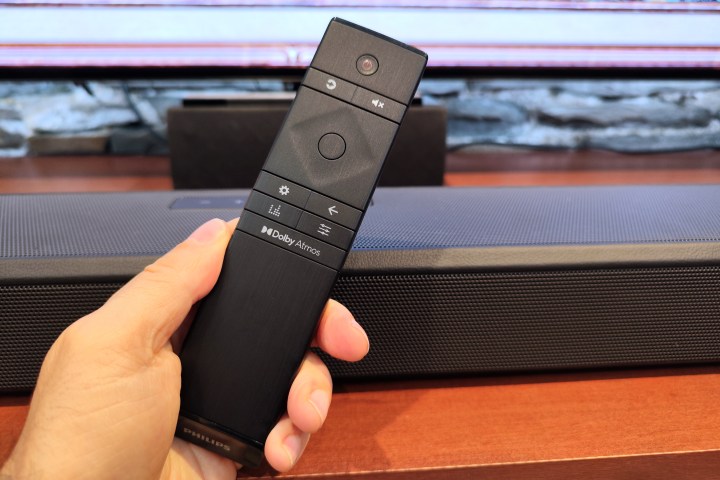
The one real critique I have — and I’ve seen this mirrored on other Fidelio FB1 reviews — is that the sound can be a tad harsh at times. It’s almost as though the tweeters are being too forcefully driven, resulting in some minor but noticeable distortion; it can rob the midranges of detail and subtlety.
You should calibrate the speaker using the included mic (page 20 of the full manual; you’re welcome, Philips). If you’re still not satisfied with its performance, there are four main ways you can tweak the sound of the FB1. I recommend you try them in this order:
- Use the Dolby Atmos button on the remote to cycle through the four height channel levels. This primarily affects the power of the overhead sounds when listening to Atmos content, but it can have a milder effect on other sound formats too.
- Use the EQ effect button to cycle through Movie, Music, Voice, Stadium, and Custom modes to hear what these do to your audio (Movie is the default).
- Use the sound enhancement menus to control parameters like surround mode, bass and treble levels, dialogue levels, etc.
- Adjust the individual channel levels in the setup menu. This is where you should tread lightly. I increased the levels of the center and side speakers, to get a more immersive experience, and I was greeted with even more harshness. I ended up retreating to the default settings and bumped up the Atmos channels to their highest levels.
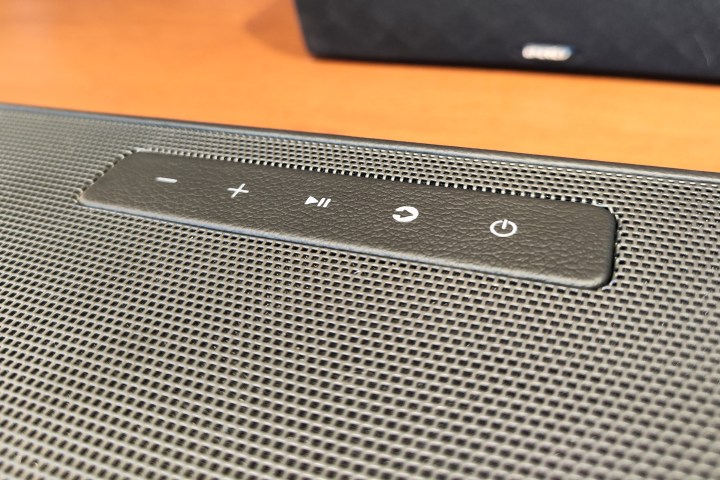
I also recommend that if you’re determined to tweak these settings, use the PS Fine Tune app. It’s not a great app if I’m being honest — it often stops communicating with the speaker, forcing an app restart — but it’s better than doing these tweaks with the remote. There’s also the benefit of seeing and adjusting your bass/treble levels within each EQ effect, which is a nice touch.
The one setting you should steer clear of is the surround option, which lets you switch between standard, upmix, and AI surround. Neither the upmix nor the AI surround modes did especially good things for TV or movie soundtracks, but they were especially unpleasant when used with music.
Music playback, however, can be very rewarding on the Fidelio FB1, but here’s what I’ve discovered. Bluetooth is decent if you’re streaming Spotify or any other lossy, low-res music. But for a much-improved experience, it’s better to use AirPlay (for Apple devices) or Chromecast (Android and select iOS apps). You’ll get far better fidelity this way, especially if you have access to lossless, hi-res tracks from Apple Music, Amazon Music, or Tidal.
It might just be my brain playing tricks on me, but I found that the very best music quality came from using the supported music sources within the Philips Sound app. Unfortunately, Apple Music isn’t one of them, but most of the others are there, including Amazon Music, Tidal, Spotify, Deezer, Pandora, Qobuz, SiriusXM, and iHeartRadio. There’s also the ability to pick music directly from your phone’s storage, or from your personal music library if you have a media server.
Play-Fi blues
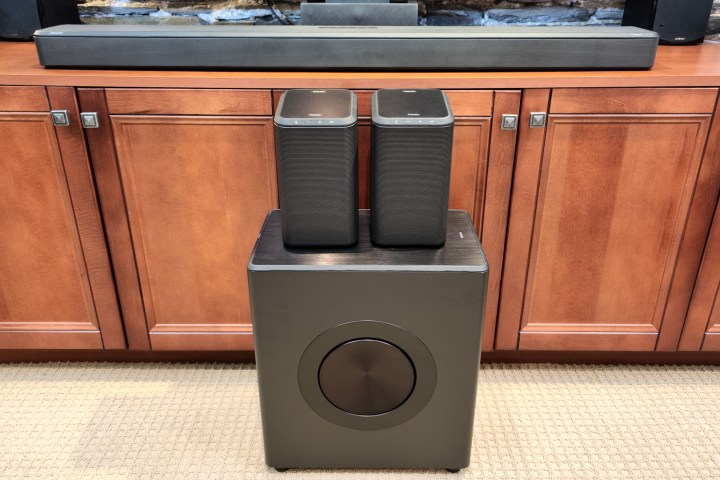
Now let’s talk about adding a subwoofer and surround speakers to the Fidelio FB1. It’s an option that Philips supports with its Fidelio FS1 wireless speakers ($300 each) and Fidelio FW1 Wireless Subwoofer ($500).
It’s the kind of setup that should be effortless. Sony, Bose, and Sonos have certainly figured out how to do so. And yet, due to the awkwardness imposed by the two apps and DTS Play-Fi, it proved awkward in the extreme. I’m not sure which part annoyed me more — the fact that the procedures for getting the FS1 and the FW1 connected to Wi-Fi differ from each other, or that, once they’re connected, you have to guess your way through the process of adding them to the soundbar (there’s no mention of how to do this in the manuals).
I have no doubt that if the DTS Play-Fi system wasn’t at the heart of the wireless connections between these components, I’d have been treated to a pretty stellar surround sound experience. These speakers certainly look good on paper, especially the FS1 speakers, with their three-way drivers, including an up-firing 2.5-inch midrange driver.
But for the life of me, I could not get these four devices to work in harmony, even after going through several long software updates on each speaker, recalibrating the system multiple times, and generally tearing my hair out (which totally didn’t help, and now my head hurts).
What I ended up with was a set of rear surrounds that were about half a second out of sync with the Fidelio FB1 soundbar, and a subwoofer that sounded like someone had draped it in heavy, wet animal skin. Worse yet, the built-in subwoofers in the FB1 started producing an annoying thumping echo when low-voiced actors spoke. My family revolted about 10 minutes into an episode of Better Call Saul, and I was forced to unpair the sub and surrounds.
Audio issues like these can be frustrating enough, but I also struggle with the way the PS Fine Tune app treats these speakers once they’re grouped into a single home theater setup. The FS1 are equipped with Philips’ Ambilight LEDs. And yet, once grouped as surrounds for the FB1, you can’t adjust the LED behavior. They’ll keep doing whatever they were set to do prior to grouping them.
And despite the FB1’s impressive array of level options for each channel, the FS1’s own settings cannot be independently controlled inside a home theater group.
In a call with a Philips spokesperson, I was told that firmware updates were planned as some of these problems were known bugs, so it’s entirely possible that this will be resolved shortly. But I can’t quite let go of the nagging feeling that Philips jumped the gun on the release of the FB1 before it had fully figured out the user experience.
As a single-speaker solution, the Philips Fidelio FB1 is impressive. It can go toe-to-toe with much more expensive soundbars, and delivers a Dolby Atmos experience that can’t be beaten at its price. It’s one of the few soundbars that can convince you that a subwoofer is a nice-to-have, not a need-to-have.
And yet its reliance on the DTS Play-Fi system for adding wireless subs and surrounds is a liability, both in terms of complexity (two apps versus one) and performance. In this regard, it has a lot of catching up to do if it wants to outshine (or even equal) the more mature offerings from Bose, Sony, and especially Sonos.

